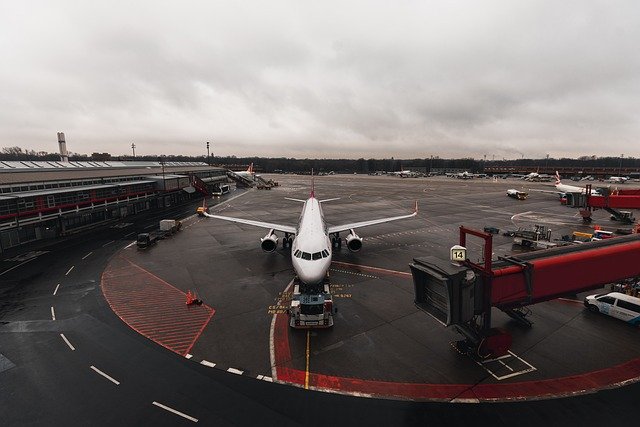ELPAC Oral Interaction – Picture Description 5
In the exam, you are expected to explain the pictures verbally. Below is the text version of the verbal explanations at different levels.

Level 6 Response
Level 6 Voice Recording of the Response
The image depicts a commercial aircraft stationed at an airport gate on a cloudy day. The airplane is centrally positioned, facing the camera, with the jet bridge connected to the front left door, indicating preparation for passenger boarding or disembarkation. Surrounding the aircraft, there is ground support equipment, including a baggage cart near the aircraft’s nose and service vehicles scattered around the tarmac. The airport terminal is visible on the left side of the image, featuring a series of windows and a covered walkway extending toward the airplane. The scene reflects typical airport operations, showcasing the infrastructure and logistical elements essential for handling commercial flights. The overcast sky suggests it might be a day with potential weather-related operational considerations.
Why Level 6
Fluency and Coherence: The narrative flows smoothly without unnecessary pauses or fillers. Each sentence logically follows the previous one, creating a coherent picture of the scene.
Comprehensive Vocabulary: The vocabulary used is precise and varied, including specific terms like “commercial aircraft,” “jet bridge,” “ground support equipment,” and “terminal,” which accurately describe the components of the scene.
Pronunciation and Grammar: Although pronunciation cannot be assessed in written text, the grammar is impeccable, with correct use of tenses, articles, and prepositions. The sentences are complex yet clear, demonstrating an advanced understanding of English syntax.
Contextual Appropriateness: The description is contextually appropriate for an aviation setting, highlighting relevant operational aspects like passenger boarding, ground support, and weather considerations. It reflects a thorough understanding of airport operations.
Idiomatic Proficiency: The description includes idiomatic expressions and natural language use, such as “centrally positioned” and “weather-related operational considerations,” which enhance the overall readability and authenticity of the description.
Level 4-5 Response
The image shows an airplane parked at an airport gate. The plane is positioned in the center, facing towards the viewer. A jet bridge is connected to the front door on the left side, likely for passengers to board or leave the plane. There are several ground vehicles and equipment around the aircraft, such as a baggage cart near the front and other service vehicles. On the left side, part of the airport terminal building is visible, with windows and a walkway leading to the plane. The sky is cloudy, suggesting it might be overcast.
Why level 4-5
Fluency and Coherence: The description is generally fluent with minor hesitations. The sentences are mostly straightforward, providing a clear but somewhat basic narrative of the scene.
Vocabulary Range and Accuracy: The vocabulary used is appropriate but less varied and specific than in a Level 6 description. Terms like “airplane,” “jet bridge,” “baggage cart,” and “terminal building” are correctly used but lack the more detailed and varied terminology seen at higher levels.
Grammatical Structure: The grammar is mostly correct, though simpler and less complex than Level 6. The description relies on basic sentence structures, avoiding more sophisticated grammatical forms.
Contextual Appropriateness: The description appropriately focuses on key elements of the airport scene, but it does not delve into as much detail about operational aspects or potential implications of the weather as a Level 6 description would.
Pronunciation and Idiomatic Usage: While not assessable in written form, the written text lacks idiomatic expressions and advanced language use. The language is clear and understandable but more functional and less nuanced.
This aligns with Level 5-4 standards, which expect clear and effective communication with occasional lapses in fluency and a less sophisticated command of vocabulary and grammar.
Level 2-3 Response
The picture shows an airplane at the airport. The airplane is in front. There is a bridge connected to the door on the left side. Some cars and equipment are around the plane, like a baggage cart near the front. The airport building is on the left side with windows. The sky is gray and cloudy.
Why level 2-3
Fluency and Coherence: The description is basic and lacks fluidity, with short, simple sentences that do not flow as smoothly as higher-level descriptions. There are pauses and the narrative is less cohesive.
Vocabulary Range and Accuracy: The vocabulary is limited and repetitive, using basic terms like “airplane,” “bridge,” “door,” “cars,” and “equipment” without more specific or varied terminology. There is a lack of precision and richness in the language.
Grammatical Structure: The grammar is simple and sometimes incomplete. The sentences are primarily straightforward and elementary, avoiding complex structures. There are occasional errors or awkward constructions.
Contextual Appropriateness: The description covers the main elements of the scene but does so in a very basic manner, without providing deeper context or detail about the operational aspects of the airport environment.
Pronunciation and Idiomatic Usage: While pronunciation cannot be assessed in text, the written description lacks idiomatic expressions and advanced language use. The language is functional but very basic and sometimes fragmented.
This aligns with Level 3-2 standards, which expect basic communication skills with limited vocabulary and simple grammatical structures, resulting in descriptions that are clear but rudimentary and lacking in detail.